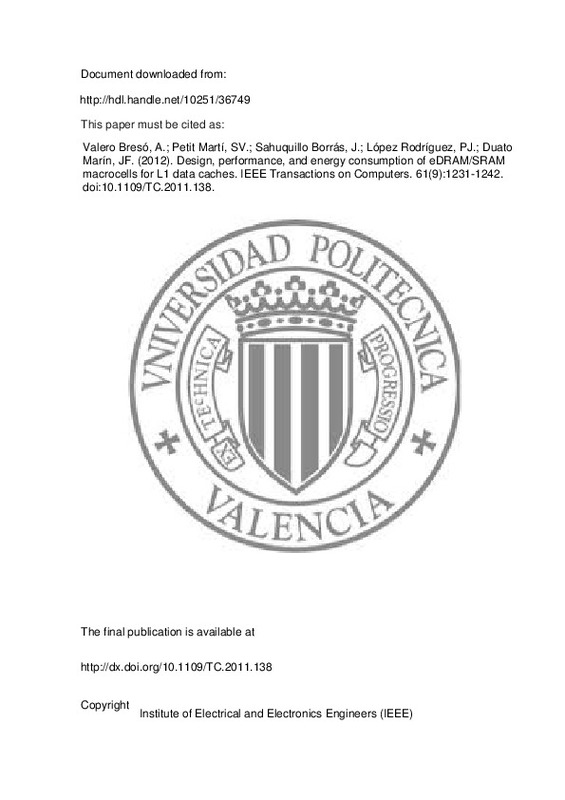Valero Bresó, A.; Petit Martí, SV.; Sahuquillo Borrás, J.; López Rodríguez, PJ.; Duato Marín, JF. (2012). Design, performance, and energy consumption of eDRAM/SRAM macrocells for L1 data caches. IEEE Transactions on Computers. 61(9):1231-1242. https://doi.org/10.1109/TC.2011.138
Por favor, use este identificador para citar o enlazar este ítem: http://hdl.handle.net/10251/36749
|
Título:
|
Design, performance, and energy consumption of eDRAM/SRAM macrocells for L1 data caches
|
|
Autor:
|
 Valero Bresó, Alejandro
Valero Bresó, Alejandro

 Petit Martí, Salvador Vicente
Petit Martí, Salvador Vicente

 Sahuquillo Borrás, Julio
Sahuquillo Borrás, Julio

 López Rodríguez, Pedro Juan
Duato Marín, José Francisco
López Rodríguez, Pedro Juan
Duato Marín, José Francisco
|
|
Entidad UPV:
|
Universitat Politècnica de València. Departamento de Informática de Sistemas y Computadores - Departament d'Informàtica de Sistemes i Computadors
|
|
Fecha difusión:
|
|
|
Resumen:
|
SRAM and DRAM have been the predominant technologies used to implement memory cells in computer systems, each one having its advantages and shortcomings. SRAM cells are faster and require no refresh since reads are not ...[+]
SRAM and DRAM have been the predominant technologies used to implement memory cells in computer systems, each one having its advantages and shortcomings. SRAM cells are faster and require no refresh since reads are not destructive. In contrast, DRAM cells provide higher density and minimal leakage energy since there are no paths within the cell from Vdd to ground. Recently, DRAM cells have been embedded in logic-based technology (eDRAM), thus overcoming the speed limit of typical DRAM cells. In this paper, we propose a hybrid n-bit macrocell that implements one SRAM cell and n-1 eDRAM cells. This cell is aimed at being used in an n-way set-associative first-level data cache. Architectural mechanisms (e.g., special writeback policies) have been devised to completely avoid refresh logic. Performance, energy, and area have been analyzed in detail. Experimental results show that using
typical eDRAM capacitors, and compared to a conventional cache, a 4-way set-associative hybrid cache reduces both energy consumption and area up to 54 and 29 percent, respectively, while having negligible impact on performance (less than 2 percent).
[-]
|
|
Palabras clave:
|
Retention time
,
Static and dynamic energy
,
Static and dynamic memory cells
,
Way prediction
|
|
Derechos de uso:
|
Reserva de todos los derechos
|
|
Fuente:
|
IEEE Transactions on Computers. (issn:
0018-9340
)
|
|
DOI:
|
10.1109/TC.2011.138
|
|
Editorial:
|
Institute of Electrical and Electronics Engineers (IEEE)
|
|
Versión del editor:
|
http://dx.doi.org/10.1109/TC.2011.138
|
|
Código del Proyecto:
|
info:eu-repo/grantAgreement/MEC//CSD2006-00046/ES/Arquitecturas fiables y de altas prestaciones para centros de proceso de datos y servidores de Internet/
info:eu-repo/grantAgreement/MICINN//TIN2009-14475-C04-01/ES/Arquitecturas De Servidores, Aplicaciones Y Servicios/
|
|
Descripción:
|
(c) 2012 IEEE. Personal use of this material is permitted. Permission from IEEE must be obtained for all other users, including reprinting/ republishing this material for advertising or promotional purposes, creating new collective works for resale or redistribution to servers or lists, or reuse of any copyrighted components of this work in other works
|
|
Agradecimientos:
|
This work was supported by the Spanish Ministerio de Ciencia e Innovacion (MICINN), and jointly financed with Plan E funds under Grant TIN2009-14475-C04-01 and by Consolider-Ingenio 2010 under Grant CSD2006-00046.
|
|
Tipo:
|
Artículo
|







![[Cerrado]](/themes/UPV/images/candado.png)


